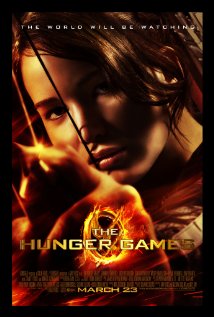
The brilliant Master Cat! Jessica Brody is the bestselling author of five novels for teens and adults. Her books have been published in over 12 foreign countries and her forthcoming novel, 52 Reasons to Hate My Father, was recently optioned for film. Visit her online at www.jessicabrody.com.
After reading the The Hunger Games series (twice) and seeing the first movie (four times), I feel comfortable calling myself a Hunger Games expert (and possibly bordering on obsessed).
I was thrilled when I sat down to write the The Hunger Games novel beat sheet and found that the book very neatly covered all 15 beats. In fact, the book so effortlessly follows the BS2, I use it as one of my go-to examples when teaching the Save the Cat! Novel Writing Workshop.
And as a true fan, I was even more thrilled to see how closely the movie followed the book, even when it came to the beats!
Of course, there are a few key differences which I’ll mention in this blog post. So let’s dive in and see how the movie and book compare when it comes to Blake’s beats. Below is the MOVIE beat sheet (with the primary departures from the book highlighted).
If you want to read the entire novel beat sheet you can view it here.
Written by: Gary Ross and Suzanne Collins and Billy Ray (screenplay); Suzanne Collins (novel)
Directed by: Gary Ross
Length: 133 minutes (not including credits)
Genre: Dude with a Problem
Opening Image (1)
Superimposed text giving us a brief history of this world we’re about to enter and the Hunger Games themselves. Then we cut right to an interview with Caesar Flickerman and head gamemaker Seneca Crane, discussing the games.
Book Comparison: Because the book is told in first person, our opening image is with Katniss. Waking up in her house. A glimpse of her underprivileged life. But the movie gets there quickly. In the very next scene, we see Prim, Katniss’s sister, waking up screaming from a nightmare and Katniss immediately there to calm her.
The effect is the same when it comes to a first glimpse at our main character: she’s in protection mode. Her one and only priority is survival.
Theme Stated (6)
Katniss meets Gale in the woods where he says, “We could do it, you know. Take off, live in the woods. It’s what we do anyway.”
Gale is introducing Katniss to the lesson she will eventually have to learn before this movie is over. She has to learn how to break free from her innate need to survive and realize that her journey is about more than just survival. It’s about standing up against something that is wrong. It’s about rebellion.
But of course, like any hero at the beginning of the journey, Katniss is resistant to the idea. She immediately dismisses it.
Book Comparison: The theme stated is almost word for word from the book. The moviemakers clearly agreed with Suzanne Collins’s theme.
Set-Up (1-14)
In the first 10 minutes of the movie we are introduced to the run down, impoverished world of District 12, as well as Katniss, her family (her warm relationship with her sister vs. the cold relationship with her mother), and Gale, her friend (although there are hints of something more than friendship there).
We also see the town getting ready for the big event of the day: The Reaping.
Book Comparison: The movie follows the book pretty closely here. We see a few new things thanks to the movie being able to depart from the first person narrative of the book and give us some new perspectives of the town, but the key ingredients of the set-up are the same: a poor district, a girl who will do anything to survive and protect her family, including breaking the law and trespassing into the woods.
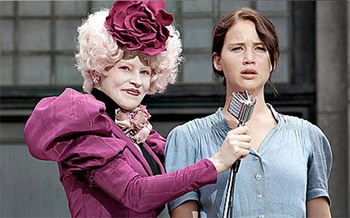
Catalyst (14)
Prim’s name is called at the Reaping and Katniss steps up to volunteer in her place. It is clear now, after a quick video from the Capitol explaining what the Hunger Games are, that things will never be the same for Katniss. She’s off to fight to the death in an arena against 23 other teens. Talk about a life changing event!
Book Comparison: Once again, the moviemakers have stayed true to the book, creating an identical catalyst moment.
B-Story (17)
Peeta’s name is called at exactly minute 17, introducing him as the B-Story. Peeta will be the “love story” of this movie, even if some might argue that their “love” is fake and only for the cameras. But what’s important is not whether Katniss’s feelings for Peeta are genuine or not (although I would argue that by the end of the story, there are hints of true emotion on Katniss’s part), but rather, what Peeta will teach Katniss by the time the credits roll. And that is, of course… the theme. That there’s more to these games than “winning” (or surviving). The real winner is the one who will stand up to the evils of the Capitol.
Book Comparison: Why change a perfectly good B Story? Clearly the moviemakers couldn’t answer this question because Peeta plays the same B-Story role in the book.
Debate (14 – 28)
From the moment Katniss volunteers as tribute, she’s launched right into a grand debate. Of course, the question of this debate isn’t whether or not she will go to the Hunger Games (she doesn’t have a choice), but whether or not she can win. And how.
The first half of the debate is spent in the holding room where she says goodbye to Gale, her sister, and her mom. Her sister verbalizes the question of the debate when she says, “Maybe you can win.” And Katniss replies. “Maybe I can. I am smart you know?” Gale also gives her advice on how to win: “Get to a bow.”
The second half of the debate is spent on the train with Haymitch, the District 12 victor who is supposed to mentor Katniss and Peeta in the games. It could be argued that as a “mentor” Haymitch is a contender for the B Story role but because Haymitch’s message (and his goal) is all about “survival” and not necessarily about “rebellion” (which is the theme), I would still maintain that Peeta fits the B Story role better. Haymitch, if anything, is a representative of Katniss’s old way of life: Doing whatever it takes to survive. As her mentor in the games, his entire purpose is to keep her alive. He even gives her advice about this in the debate section. “You really wanna know how to stay alive? You get people to like you.” This is a clear message about playing the game to survive. But Katniss already knows this. This is her M.O. What she really needs to learn is how to rebel against the games. Not play into them.
Book Comparison: Although the scenes and dialogue play out a bit differently, the debate beat is exactly the same. The question is still: Can I win the games? And if so, how?

Break into 2 (28)
The moviemakers, obviously recognizing the importance of a clear break into 2, did a phenomenal job of visually departing the old world, and entering the new world of act 2. Exactly at minute 28 is when the train enters a dark tunnel and emerges into the upside-down world of the Capitol. The buildings are tall and impressive, the people are dressed like aliens, everything about it screams “wealth and prosperity!” A stark contrast from the impoverished world of district 12 that we just left behind.
Book Comparison: Once again, we are beat for beat with the book. The break into 2 of The Hunger Games novel comes at the same moment: leaving the old world and entering the new world of the Capitol.
Fun & Games (28 – 67)
Although the movie is called The Hunger Games, the actual games don’t begin until later, at the midpoint. Instead the moviemakers used their Fun & Games time to prepare the audience (and the tributes) for the upcoming event. We see our hero getting primped, trained, dressed, tested, interviewed, and of course, the famous scene from the book when Katniss becomes the “Girl on Fire” in the opening ceremonies. All of this build- up, leading to the games, is effective in hyping up the games themselves.
But even though this F&G is not exactly the “promise of the premise” (although I would argue that training for the games is just as much part of the premise as the games themselves), Blake’s theory that the Fun & Games section is usually where you’ll find all the trailer moments still holds true. If you look back at the first The Hunger Games trailer (the one that set the Internet ablaze with excitement), you’ll notice that all of the trailer moments happen before the games begin. And the trailer ends just as the games are beginning.
Also in this section is where we see Peeta living up to his B Story title when he restates the theme the night before the games begin (at minute 61). “I don’t want to be another piece in their games,” he says, “I just keep wishing I could think of a way to show them that they don’t own me. If I’m gonna die, I wanna still be me.” This is the exact lesson that Katniss needs to learn. But of course, she dismisses it here. “I just can’t afford to think like that.” Because she still hasn’t learned the theme. (Otherwise the movie would be over!)
Book Comparison: The F&G section is where the book and the movie differ somewhat. The moviemakers made a clear choice to focus more on the lead up to the games, while Suzanne Collins only spent half of her F&G section in the preparation and the remainder of the F&G section in the games themselves. By the time the book is halfway finished and we’ve reached the midpoint, Katniss has already been in the arena for a few nights. But the moviemakers don’t choose to bring us into the arena until….
Midpoint (67)
Exactly halfway through the movie we enter the arena and once again the moviemakers have done an excellent job at visually moving us into the next stage of the story. At minute 67, Katniss is in the “tube” as it makes its slow and dramatic climb through the darkness into the light of the second half of act 2, bringing her officially into the Hunger Games. Blake says at the midpoint the stakes need to be raised and I can’t think of any better way to raise stakes than to enter into a fight to the death. And the visual “rising” of her platform as she enters the unknown arena is brilliantly symbolic of rising stakes.
Book Comparison: As I mentioned before, at the midpoint of the book, Katniss is already in the arena. The “stakes are raised” moment of the book is when Peeta saves Katniss’s life and she realizes that maybe he’s not just playing a game. Maybe he really does love her. This is a harder realization to portray on screen, especially since we’re not in Katniss’s head the way we are in the book, so I think the choice to change this beat was a smart decision on the part of the moviemakers.
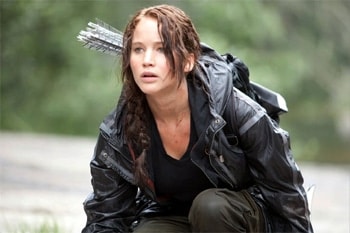
Bad Guys Close In (67 – 98)
Naturally, now that we’re in the arena, bad guys are closing in from all around — 23 of them, to be precise. The majority of the actual “games” are brought to life in this exciting section as Katniss battles fires, injuries, careers, tracker jackers, and conniving gamemakers.
Toward the end of this section, Katniss pairs up with Rue, the young tribute from District 11. A friendship is formed and they make a plan to destroy the food supply of the career tributes.
Book Comparison: The movie quickly catches up to the book in this Bad Guys Close In section. But because the moviemakers had much less time to devote to the games themselves, a lot of Katniss’s struggles in the arena have been abridged. One big struggle that was almost entirely cut in the movie was her quest for water. In the book she spent pages and pages looking for a water source, and almost died of dehydration. In the film, she finds water within minutes.
Another glaring difference here is the abbreviated amount of time the moviemakers spent to build Katniss and Rue’s relationship. In the movie, they are teamed up for only a total of 8 minutes, while in the book, their relationship was able to blossom over several chapters. In fact, nearly the entire Bad Guys Close In section of the book is dedicated to the Rue/Katniss alliance, leaving the movie adaptation of this friendship feeling a bit rushed and unfulfilling.
But by the time we reach the All Is Lost, the book and the movie are completely back in sync… beat for beat.
All Is Lost (98)
Katniss returns from blowing up the Career’s food to find Rue stuck in a trap. Rue is shot down by a spear. A very strong whiff of death moment when Katniss sings to Rue as she dies.
Book Comparison: This is an identical beat to the book.
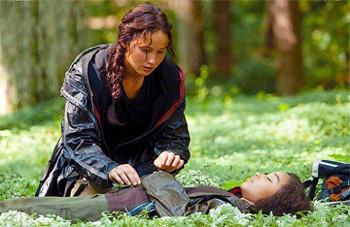
Dark Night of the Soul (98 – 106)
Katniss mourns Rue’s death by decorating her body with flowers. Her first official act of rebellion against the Capitol. And she doesn’t stop there! She turns to the sky and lifts three fingers upward, a symbol that was established earlier during the catalyst moment as an act of defiance. Katniss’s transformation from survival-obsessed girl who will do anything to win, to the leader of a revolution is nearly complete!
And while Katniss is quietly rebelling against the Capitol, the moviemakers once again create a fantastic visual counterpart to help get the message across. They cut to District 11’s reaction to Rue’s death which is a full scale violent uprising. A clear sign that things are changing. Not just for our hero, but in the world she inhabits as well.
Book Comparison: Although Katniss’s beat is exactly the same in the book (flower burial and a quiet rebellion aimed at the sky), in the movie we have the benefit of being able to leave Katniss’s POV and see the world beyond her eyes. And with that opportunity, the moviemakers decided to show a rebellion in District 11 (which is not in the book) but which I believe served the right purpose in aiding the forward motion of Katniss’s journey.
Break into 3 (106)
The gamemakers announce a “rule change,” stating that two tributes may win if they are from the same district. Katniss immediately thinks of Peeta and heads off to find him. She makes an active step into 3.
Book Comparison: This beat is nearly identical to the one in the book, except in the book Katniss involuntarily calls out Peeta’s name when she hears the rule change, putting her life in danger in the process. I think this might be a stronger beat than the version in the movie, as it shows how drastically her instincts have changed. The earlier Katniss would never put her life in danger (risk her survival) so carelessly like that. But by now her priorities have clearly changed.
Finale (106 – 133)
The movie follows a perfect Five-Point Finale:
1) Gathering the Troops – Now that Katniss knows both she and Peeta can win the games together she has a new plan! She sets off to “gather” Peeta as her teammate and eventually finds him near the river, buried in rocks and badly injured.
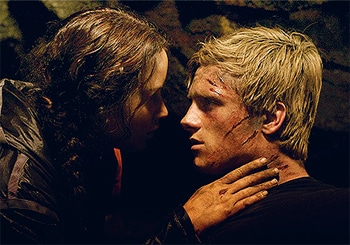
2) Storming the Castle – Katniss and Peeta weather out the remainder of the games together — bunkering down in the cave, kissing, talking. Although most of the affections between them are for the cameras (at least in Katniss’s mind), she does prove that she’s learned the theme when she risks her life to get Peeta’s medicine. She could have easily just stayed put and let him die. She didn’t need him to win. But she proves that there are more important things than just winning. Then once they’ve outrun the crazy genetically modified dogs and landed back at the Cornucopia, they have to take down Cato, which they do with some strategic teamwork. Even though all the other tributes are now dead, that’s not the end. Because in a five point finale there’s always a…
3) High Tower Surprise – The gamemakers announce that they’ve changed the rules back. Now only one tribute can win. Katniss realizes at this moment that she’s been duped by the Capitol.
4) Dig Deep Down – Here is the ultimate test. Has Katniss really learned the theme? Will she rebel against the Capitol that fooled her and played with her emotions, all for the sake of a “good show”? Or will she continue to play by their rules, shoot Peeta, and claim her title? Of course, she will choose the former. But how can she possibly rebel? How can she beat the Capitol? It’s something Peeta says (Go B Story!) that inspires her answer. “One of us has to die. They have to have their victor.” To which Katniss digs deep down, realizes what she has to do and says, “No. They don’t.”
5) Executing the New Plan – Katniss proves once and for all that she’s not going to be a “piece in their games” (just as Peeta said earlier!). She holds out the deadly berries to Peeta and tells him that they will eat them together. They both will die. This is the ultimate demonstration of the theme. She is literally giving up her life (her relentless need to survive) in order to revolt against the Capitol. It’s no longer about winning for her. It’s about so much more: Righting an epic wrong. The gamemakers, realizing what they’re about to do, stop them just in time and declare they are both winners. Peeta and Katniss leave the arena, are crowned victors, and return home to District 12 together.
But the Capitol is angry. They don’t like being shown up. And it’s clear, they’re not finished with the Girl on Fire.
Book Comparison: The five-point finale follows the book almost word for word.
Final Image (133)
President Snow watches Katniss’s joyous homecoming on a TV screen with a look of quiet rage in his eyes. He turns and leaves, silently vowing revenge.
Book Comparison: Like the opening image, the movie and book differ on this beat. In the book, we end on Katniss arriving back in District 12, preparing to face the cameras and the crowd. But the moviemakers chose to show a few moments beyond this. We get to see Katniss’s return home. We see the crowd that welcomes her. And we see the look of uncertainty on her face. Even though she has come a long way from the girl who left this district, she knows her journey is far from over.
Check out our other novel-writing blog posts.
Jessica Brody
11 Comments
Leave a Reply Cancel reply
You must be logged in to post a comment.


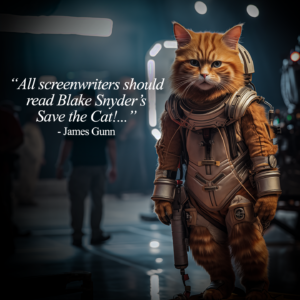






I have not read the book. Every beat may be in the the movie but are so weakly present/executed/turned that this movie was mush in my mouth.
The Antagonist/Protagonist Caesar Flickerman journey is — well why present it so weakly. Why even have him appear to end up a good guy?
Thing falling out the sky by sponsors reminds me of what was said about old Greek plays – when all else fails the Gods step in to help the hero… Yuck. Not drama to it.
Sorry but a film that has every beat but doesn’t execute them waste an opporturnity to tell the story.
And last, without reading the book, is this no more then a teeny booper love life movie (with violence)like Twilight?
All comments base on what I learned from…… Save the Cat.
Thank you for this excellent breakdown!
Thanks for the effort, but isn’t the genre actually Institutionalized? Where the choice is join or fight?
Thank you for this is excellent, articulate, breakdown, but just because a movie religiously follows Blake’s beats doesn’t mean it’s good. They just increase your odds from making a bad one. The Hunger Games left me… hungry.
Here’s why:
I found Katniss an extremely bland main character. Yeah, the filmmakers did their darnedest to try to make me care/root/get behind her, but I never did because she was passive. Yeah, she took her sister’s place, but after that she weakly walked through the journey. What was suppose to be the most exciting part of the movie, the hunger games in the forest, were boring. It was like watching district 12 oatmeal harden. You used the word hint a lot and a hint of salt didn’t cut it. Milk for babes, meat for men!
Her transformation, which is what story is all about was… ineffective. Also, worst of all she didn’t make the world a better place. I’m not even sure she’s better for having taken the journey. She still seems like the wishy-washy girl who left. Does she love Peeta, not really. Does she love Gale, no clue, why? Because she’s given me nothing to care about.
This movie is a lot like Arnie’s The Running Man, but at least Arnie made his world better and he truly helped foster a rebellion. In The Truman Show, Truman was active and really stood up to his creator, Christof. When he walked out on the show that was a true-Man act of rebellion. The name Katniss
fits her; walked softly and disappeared quietly into the shadows of the night.
I rate this movie as “the Emperor Has No Clothes.” I could try to see all sorts of things going on in this vapid film that just weren’t there, except that it followed the beats to a T.
@ smile
Yea, there was a minimal development in character, but my guess is you can look at this whole movie as the first act in a three act story, as it’s to be followed up by the next two acts, or stories. For example if luke redeemed his father at the end of star wars, no trilogy would be needed, but expanded, it is. So flimsy character development here is almost justified, and if it continues on this slow progression, I see her being pulled along into the rebellion more swiftly and play a more leading role.
@ Robert
Good call on the Gods thing, the sense of urgency did not exist, and they should have made a stronger ticking clock, and had the games set up like basketball, with overtimes, and fiercer obstacles placed at each one, instead of changing it from night to day in an attempt to do… What? I’ve seen the movie twice and the second time the flaws really stood out. I will say tho, that first transition from the game maker to the scream, solid.
@Thomas Gowan
I don’t buy the extrapolation of this movie being the first act in a three act story. A film is required to do certain things without relying on sequels which may never come about. You are letting the filmmakers off far too easily. This film failed. It teased but did not deliver on the “promise of the premise.”
Thanks Jessica for the breakdown. It hits Blake’s beats perfectly!
I took my teenage daughters to see the movie and they absolutely loved it – and they had also read the book. Whilst we all agreed that the movie wasn’t anywhere near as good as the book, it was still entertaining and captured the imaginations of the intended viewer – teenagers.
It was a commercial success and was written for the audience, not screenwriters/filmakers/novelists/directors/producers/etc.
Duh… BS genre is “Superhero” (I think!)
Although this film started so strongly… it failed because it tried to meet a young audience… you simply don’t feel the dark nature of the games… of a child killing another child which the novelist captures so brilliantly… Yes it follows Snyders beat sheet… but it fails… what annoyed me most about the production was the gritty realism with which is was filmed juxtaposed by the powder puff nature they dealt with the gore…
Although this film started so strongly… it failed because it tried to meet a young audience… you simply don’t feel the dark nature of the games… of a child killing another child which the novelist captures so brilliantly… Yes it follows Snyders beat sheet… but it fails… what annoyed me most about the production was the gritty realism with which is was filmed juxtaposed by the powder puff nature they dealt with the gore…
Worst movie ever made. Miss I-live-in-the-woods later asks Woody Harrelson “How do you find shelter in the wilderness?”. Every dramatic scene is her getting hit on the head or stung by bees and waking up just in time ti save herself. She somehow goes through an entire movie about survival of the fittest without being responsible for a single death (even the deer at the beginning is spared). She’s lived her entire life in a society where the chosen battle to the death and everyone watches on huge screens, yet is ignorant of the most basic rules of the game. She supposedly sells wild game to the baker, yet ask whether the bread “is real” (like they’d make fake bread, the cheapest of calories, out of clay and sawdust or something). She triumphs over the baddies by firing a well-placed arrow into a sack of apples helpfully strung above a field of land mines when any clod could have tossed a rock into the same spot (the baddies having been trained in the arts of survival having seen fit to booby trap their own stash of supplies so if it goes off everything goes up in smoke. This is the kind of crap screenwriters are paid to produce? We can say good bye to the American film industry….